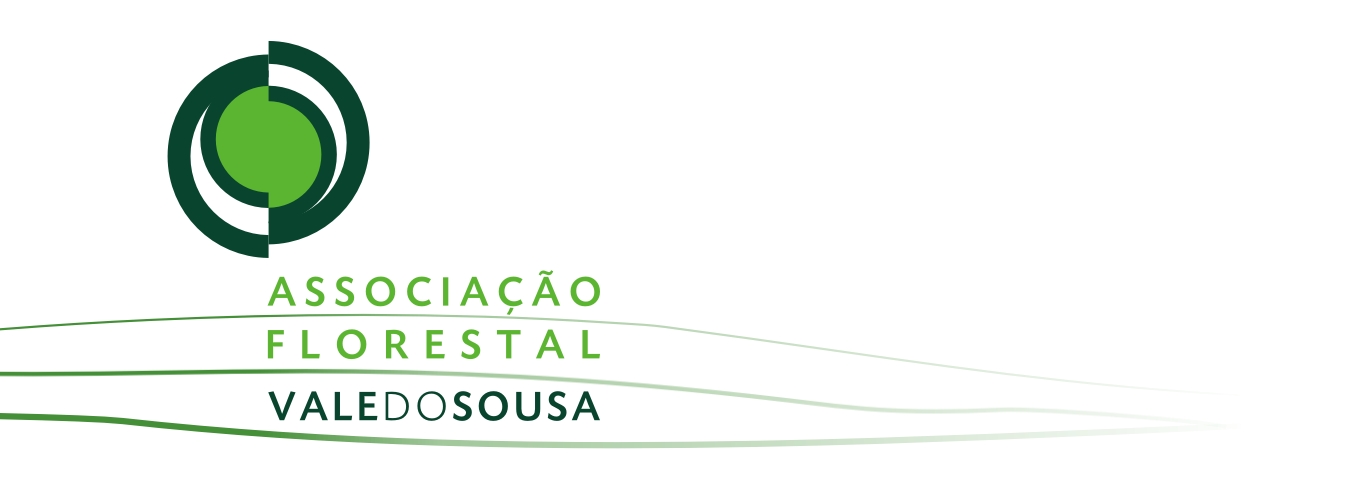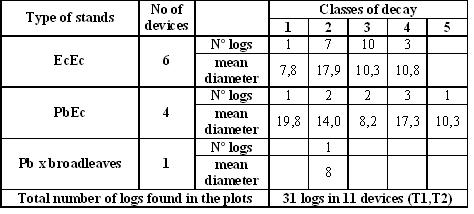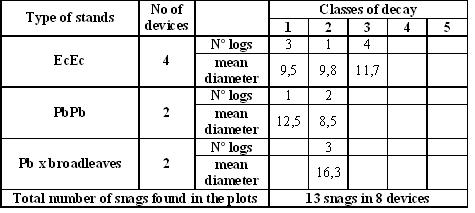Percentage of the total forest area in Sousa Valley: 14,3 %
Costs
TOTAL COST:
1820,5 €
Costs/ha:0,36 €
Costs/plot: 52 €
The total cost includes:
1- Data collection:
1793,5 €
2- Data analysis: 27 €
Results
Logs in transepts (T1, T2) and classes of decay
Source: Field sheets
In about 2/3 of the forest devices (68%) was not found any logs.
Snags in FORSEE devices (IFN and satellites)
Source: Field sheets
Volume of deadwood in the FORSEE devices
Source: 1) UTAD estimates;
2) Area corresponding to half of the municipalities of Paredes, photo interpretation 1995.
Remarks
Logs were found in 11 devices (T1 and T2) from the 35 possible; 6 devices were pure stands of Eucalyptus globulus and 5 devices were pure or mixed stands of Pinus pinaster. Probably because of the intensive management of the stands, it was not found many logs in the transepts. Managers of production forests try to keep the levels of deadwood very low due to the sanitarian problems this type wood can bring to the stands.
Given the high classes of decay (between 1 and 4) of the logs found in the 6 devices of pure stands of Eucalyptus they may correspond to abandoned or not managed stands. In the remaining devices of pure stands of Eucalyptus globulus managed by pulp and paper industries there it was not inventoried any log in the transepts.
Mixed stands of Pinus pinaster and Eucalyptus globulus are the type of stands with logs in all classes of decay, even in the highest class (class of decay number 5).
In terms of snags, they were only found in 4 devices, being classified in the lowest classes of decay.
The volume of logs found in the FORSEE transepts per hectare is 0,0215 m3.ha-1 and the volume of snags 0,004588 m3.ha-1
Problems and imrpovements
As already stated for indicator 1.4.3, the logs sampling using the line intercept method is already well documented in the forestry and ecology literature. The main problems detected during the test of this indicator were:
a) The length of the line (50 m) is very high for the size of the forest holdings in Sousa Valley. The small scale of the forest holdings and its fragmentation makes the transept cross different types of stands or even different types of land use;
b) The classification of the classes of decay;
c) The conversion of volume in biomass using wood density values.
In terms of the low levels of deadwood found in the plots, one can add that even though the intensive management of the forest stands in Sousa Valley, there were logs with a diameter < 7,5 cm that were not considered. Field team witnessed they existed in the stands but as it followed the 1st version of the FORSEE field guide (FORSEE.guideterrain.V1.es), which only asked for the measurement of logs with a diameter equal or above 7,5 cm did not note them down. This may also have contributed to the record of low levels of logs in the transepts.
Conclusions
Deadwood is an important component of forest ecosystems in providing habitat, nutrients and shelter to a range of forest organisms. This is a recognised indicator of forest biodiversity because it helps to describe the quality and status of the habitats, and the structural diversity within a forest. In Sousa Valley, and especially in the South of Paredes, where the 35 FORSEE devices were located, the forest is mainly productive and there are not many logs and snags in the stands. This may happens because its presence can increase the risks of pests and diseases and the risks of fire propagation. Thus, forest managers opt to keep logs and snags in low levels. From the field work sheets and UTAD estimates (FORSEE Data report, table 17) it was possible to record that in the devices located in pure Eucalyptus stands under active management the volume of deadwood (logs) varies between 1,5 and 5,04 while in not managed or even abandoned Eucalyptus stands (example of the devices 120 and 248) the volume of deadwood is much higher, 15,79 m3.ha-1 and 25,37 m3.ha-1 respectively. According to WWF, the volume of deadwood recommended for productive stands in order to follow sustainable forest management maintaining the conservation value of forests is 20-30 m3.ha-1 divided between logs and snags. This means that stands in Sousa Valley present a volume of deadwood (only logs considered) much lower than what is recommended by the ONG.
Nowadays, international forest policies are considering deadwood an important indicator of naturalness in forest ecosystems. It is a decision of forest managers in Sousa Valley to follow this indication and to let more logs or snags in the forest stands in order to support biodiversity or not.
Old and cavernous trees is one of the indicators of Criterion 4 considered by NP 4406 2003. NP 4406 2003 considers that most of the silvicultural systems indicate the final cut of the trees in the early ages, far from longevity. As a consequence of that practise, the forest areas usually present a scarce number of old trees and trees with big diameters. In general, the trees of big diameters have a set of natural holes which are very important as shelter to a variety of animals. These functions are also assured by dead trees.




Initiative Communaitaire FEDER
INTERREG IIIB Espace Atlantique


